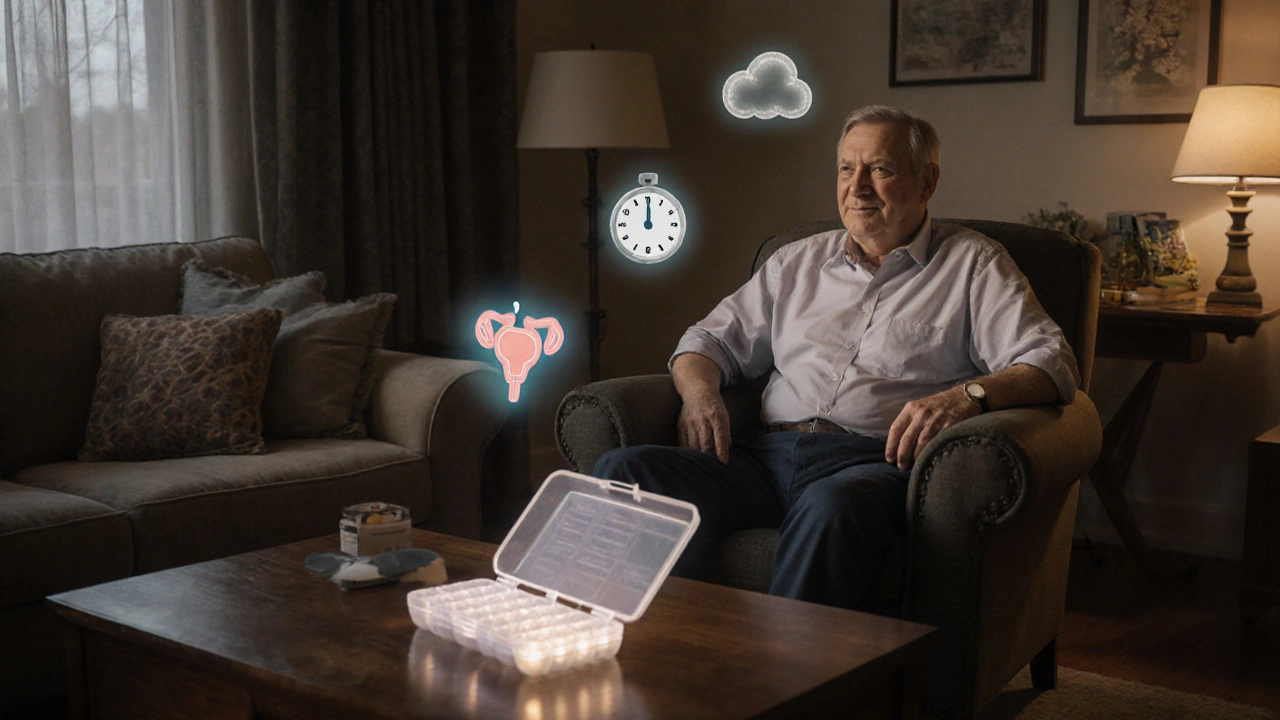Overactive Bladder Medication Selector
Select your symptoms and preferences to get a personalized recommendation.
Your Symptoms
Lifestyle & Preferences
If you’ve ever searched for relief from an overactive bladder, you’ve probably stumbled on the name Flavoxate. But is it the right choice for you, or are there better‑tasting alternatives? Below we break down how Flavoxate (branded as Urispas) stacks up against the most common bladder‑spasm medicines, so you can pick the one that fits your lifestyle and health profile.
Quick Takeaways
- Flavoxate works by relaxing bladder muscle tone without strong anticholinergic effects.
- Oxybutynin and Tolterodine are the go‑to anticholinergics for many patients, but they can cause dry mouth and constipation.
- Solifenacin and Darifenacin offer once‑daily dosing with a milder side‑effect profile.
- Mirabegron (Myrbetriq) is a non‑anticholinergic option that targets beta‑3 receptors, good for people who can’t tolerate anticholinergics.
- Cost, dosing frequency, and individual health conditions are the biggest decision factors.
How Flavoxate (Urispas) Works
Flavoxate is a muscle‑relaxant that reduces involuntary bladder contractions by stabilizing smooth‑muscle fibers. Unlike classic anticholinergics, it doesn’t block acetylcholine receptors, so you’re less likely to experience classic side effects like dry mouth or blurred vision. The standard dose is 200mg three times daily, taken with food to minimize gastrointestinal irritation.
Flavoxate is often prescribed for patients whose main complaint is urgency and frequency without significant pain. It’s especially useful when doctors want to avoid the cognitive effects that can accompany strong anticholinergics in older adults.
Key Alternatives to Consider
Below are the most widely used bladder‑spasm drugs, each with its own mechanism, dosing schedule, and side‑effect fingerprint.
Oxybutynin
Oxybutynin is an anticholinergic that blocks muscarinic receptors in the bladder, reducing involuntary contractions. It comes in immediate‑release tablets (5mg two to three times daily) and a once‑daily transdermal patch (3.9mg/24h). Common side effects include dry mouth, constipation, and blurred vision.
Tolterodine
Tolterodine also targets muscarinic receptors but with a slightly tighter affinity for bladder tissue, which can lessen systemic side effects. The extended‑release form is taken once daily at 4mg. Users often report less dry mouth than with oxybutynin, but still some urinary retention risk.
Solifenacin
Solifenacin is a selective M3‑receptor antagonist. Its once‑daily dosing (5mg or 10mg) makes adherence easy. Side‑effects are similar to other anticholinergics but tend to be milder; constipation is the most common.
Trospium
Trospium is a quaternary ammonium compound that doesn’t cross the blood‑brain barrier easily, reducing cognitive side effects. The usual dose is 20mg twice daily, but a 60mg extended‑release tablet is available once daily.
Darifenacin
Darifenacin offers high selectivity for bladder M3 receptors. It’s taken once daily at 7.5mg or 15mg. Its main downside is cost; it’s often pricier than older generics.
Mirabegron (Myrbetriq)
Mirabegron works on beta‑3 adrenergic receptors, directly relaxing the detrusor muscle without anticholinergic activity. The starting dose is 25mg once daily, raised to 50mg if needed. It’s a solid pick for patients who can’t tolerate dry mouth or constipation.
Side‑Effect Snapshot
| Medication | Primary Mechanism | Typical Side Effects | Dosage Frequency |
|---|---|---|---|
| Flavoxate | Muscle‑relaxant (smooth‑muscle stabilizer) | GI upset, mild dizziness | 3× daily |
| Oxybutynin | Anticholinergic | Dry mouth, constipation, blurred vision | 2-3× daily (tablet) or 24h patch |
| Tolterodine | Anticholinergic (M3 selective) | Dry mouth, constipation, urinary retention | Once daily (ER) |
| Solifenacin | Anticholinergic (M3 selective) | Constipation, dry mouth | Once daily |
| Trospium | Anticholinergic (quaternary) | Blurred vision, constipation | Once or twice daily |
| Darifenacin | Anticholinergic (M3 selective) | Dry mouth, constipation | Once daily |
| Mirabegron | Beta‑3 agonist | Hypertension, nasopharyngitis, urinary retention | Once daily |

Choosing the Right Option - Decision Checklist
- Do you need a non‑anticholinergic? If you’ve experienced troublesome dry mouth or cognitive fog, Mirabegron or Flavoxate may be safer.
- How many doses can you stick to? Once‑daily drugs (Tolterodine ER, Solifenacin, Darifenacin, Mirabegron) boost adherence compared to three‑times‑daily Flavoxate.
- What’s your budget? Generic Oxybutynin and Tolterodine are usually the cheapest; newer agents like Mirabegron can be pricier but may be covered by insurance.
- Any comorbidities? Patients with glaucoma, severe constipation, or prostate enlargement should avoid strong anticholinergics and consider Flavoxate or Mirabegron.
- Age matters. Older adults often benefit from drugs with less central nervous system penetration, such as Trospium or Flavoxate.
Real‑World Scenarios
Scenario 1 - Young professional with busy schedule* Jane is 32, works long hours, and can’t remember to take meds three times a day. She tried Flavoxate but missed doses. Switching to Solifenacin 5mg once daily solved her adherence problem and reduced urgency without dry mouth.
Scenario 2 - Senior with mild cognitive concerns* Mr. Patel, 78, has early memory lapses. His doctor avoided Oxybutynin because of its anticholinergic load. Flavoxate gave him bladder relief without worsening cognition, though the three‑times‑daily schedule required a pill organizer.
Scenario 3 - Patient with uncontrolled hypertension* Sara’s blood pressure spikes with Mirabegron, so her urologist selected Tolterodine ER. She tolerated the once‑daily dose well, but occasional dry mouth means she drinks water throughout the day.
Cost Overview (2025 US Prices)
- Flavoxate (generic) - $0.15 per 200mg tablet, approx. $16/month.
- Oxybutynin (generic) - $0.08 per 5mg tablet, approx. $9/month.
- Tolterodine ER - $0.30 per 4mg tablet, approx. $35/month.
- Solifenacin - $0.45 per 5mg tablet, approx. $50/month.
- Mirabegron - $1.10 per 25mg tablet, approx. $125/month (brand); generics expected 2026.
Insurance coverage varies; many plans favor older generics, so check formularies before committing.
How to Talk to Your Doctor
Bring these points to the appointment:
- Current symptoms - urgency, frequency, nocturia.
- Any existing conditions - glaucoma, constipation, hypertension.
- Medication history - past anticholinergics and side‑effects.
- Lifestyle preferences - dosing frequency, cost concerns.
Ask the doctor to explain the mechanism, so you understand why a particular drug may suit you better.
Bottom Line
Flavoxate (Urispas) shines for patients who need bladder‑smooth‑muscle relaxation without strong anticholinergic side effects, but its three‑times‑daily schedule can be a hurdle. Alternatives like Oxybutynin and Tolterodine provide proven relief with a cheaper price tag, while newer agents such as Solifenacin, Darifenacin, and Mirabegron prioritize convenience and reduced side‑effects at a higher cost. Your choice should balance symptom control, side‑effect tolerance, dosing convenience, and budget.

Frequently Asked Questions
Can Flavoxate be used for nighttime urgency?
Yes. Because Flavoxate’s effect lasts a few hours, taking the last dose before bedtime can lessen nighttime trips. Some patients prefer a lower dose at night to avoid potential dizziness.
Is Flavoxate safe for people over 65?
Generally, yes. Its lack of strong anticholinergic activity makes it a safer option for seniors who are prone to confusion or constipation. However, the three‑daily dosing may increase the risk of missed doses, so a pill organizer is recommended.
How does Mirabegron differ from Flavoxate?
Mirabegron activates beta‑3 receptors to relax the bladder, while Flavoxate directly stabilizes smooth‑muscle fibers. Mirabegron is a non‑anticholinergic, so it avoids dry mouth, but it can raise blood pressure in some users.
Do insurance plans usually cover Flavoxate?
Flavoxate is a generic drug, so most U.S. plans list it on their formularies. Coverage levels vary, so check your specific plan’s pharmacy benefit to confirm copay amounts.
What should I do if I miss a Flavoxate dose?
Take the missed dose as soon as you remember, unless it’s almost time for the next scheduled dose. In that case, skip the missed one-don’t double up, as higher concentrations can cause dizziness.




From an ethical standpoint, the predilection toward prescribing anticholinergic agents without due consideration of their cognitive sequelae constitutes a dereliction of fiduciary duty; the pharmacoeconomic calculus must integrate neuropsychiatric risk metrics alongside traditional efficacy endpoints. Moreover, the epistemic opacity surrounding long‑term muscle‑relaxant phenotypes such as flavoxate mandates rigorous post‑marketing surveillance to preclude iatrogenic morbidity.
Alright, let’s break this down like a drama‑queen’s monologue!
First, imagine waking up at 3 AM, heart pounding, dashing to the bathroom – that’s the nightmare we’re trying to end.
Flavoxate is like the gentle sidekick that whispers, “I’ve got your back,” without the dreaded dry‑mouth drama.
But then there’s Solifenacin, the glamorous star that waltzes in once‑daily, stealing the spotlight with its sleek dosing schedule.
Oxybutynin? Think of it as the loud‑mouthed cousin who never knows when to shut up – dry mouth, constipation, the whole circus.
Mirabegron steps onto the stage as the cool, non‑anticholinergic rebel, keeping the bladder calm while staying away from the anticholinergic chaos.
Now, the cost factor – budget‑conscious folks might gravitate toward the generic champs like Oxybutynin, which is easy on the wallet.
For seniors battling memory lapses, the less‑brain‑penetrant options like Trospium or Flavoxate shine like a beacon of safety.
Adherence is a silent hero; once‑daily pills are the golden tickets, reducing missed doses and boosting outcomes.
Side‑effects? Imagine each medication as a character in a sitcom: some bring laughter (relief), others bring tears (dry mouth).
In the grand finale, the choice hinges on your lifestyle, health portrait, and how much you’re willing to pay for convenience.
Remember, you are the director of your own health narrative – the script is yours to write!
Keep fighting the urgency, stay informed, and empower your doctor with these insights. The bladder will thank you.
While the foregoing exposition extols certain therapeutics, it neglects to acknowledge the pharmacodynamic heterogeneity inherent in the antimuscarinic class. One must, therefore, exercise circumspection before promulgating blanket recommendations, lest the analysis devolve into a reductionist oversimplification.
Pharma colludes trust nothing.
Wow, look at that! Flavoxate’s three‑times‑daily schedule sounds like a nightmare, but hey, if you’re already juggling coffee, meetings, and a cat that thinks it’s a ninja, why not add another pill?; on the other hand, the cost savings of Oxybutynin are practically a charity donation to your wallet, and who doesn’t love a good bargain?; but let’s not forget the dry‑mouth saga – it’s like living in the desert without a water bottle; and Mirabegron, the shiny new kid on the block, will raise your blood pressure if you’re not careful, so keep an eye on that number!; bottom line: pick whatever fits your life, your budget, and your tolerance for side‑effects – it’s your bladder, after all.
From a pragmatic perspective, Flavoxate offers a middle ground for patients seeking muscle relaxation without the anticholinergic burden; however, the three‑daily dosing may challenge adherence, especially in older adults. Those with comorbidities like glaucoma or severe constipation might still prefer newer agents with more favorable side‑effect profiles.
Honestly, i think flavoxate is a good option but it can be a bit tricky to remember to take it three times a day. If you miss a dose, just skip it and dont double up. The costs are defintely lower than mirabegron which i love but the side effect profile is better for some.
Hey folks – just a quick heads‑up: if you’re worried about missing a 3× daily pill, try setting alarms on your phone or using a pillbox. It’s a simple hack that can make a big difference in staying on schedule, especially when juggling work and family.
Love the vibe here! Let’s keep the optimism flowing – even if you have to take meds three times a day, think of it as three reminders that you’re taking charge of your health. Small wins add up, and soon you’ll notice fewer nighttime trips and more restful sleep.
Just to point out, the word “flavoxate” was misspelled as “flavoxate” in a few places – consistency matters for clarity. Also, “once‑daily” should be hyphenated; keep an eye on those details.
Interesting read! 🤔 I still think the cost of Mirabegron is a bit steep for most people, but the lack of dry mouth is a huge plus. 👍
Sure, the guide is helpful, but let’s be real – nobody wants to pop pills three times a day unless they’re forced to. Simple is best, so if a once‑daily option works, that’s the winner in my book.
Great summary! If you’re uncertain, bring this chart to your urologist and ask which option aligns with your daily routine and budget. It’s always better to have a visual aid during the appointment.
One might contemplate the ontological implications of treating a physiological urge as a problem to be solved, yet pragmatism dictates seeking relief. The balance between bodily autonomy and medical intervention remains a nuanced discourse.
Indeed, the juxtaposition of cost versus convenience is a classic dilemma. While newer agents offer pharmacological elegance, the economic reality for many patients cannot be ignored. A measured approach, considering both efficacy and affordability, is advisable.
It is morally indefensible to prescribe a drug that could impair cognition in the elderly without exhaustive counseling; physicians bear a duty to prioritize neuro‑protective strategies over convenience.
Wow, where do I even begin? :) First off, kudos to anyone who actually read through this massive wall of text – it’s practically a novel, and I’m here for it!
Let’s talk about Flavoxate; sure, it’s three times a day, but think about the ritual – a morning dose with coffee, a midday with lunch, and an evening with Netflix. That’s practically a lifestyle upgrade, right? 🙃
On the flip side, Mirabegron sounds like a superhero name, but the price tag is more like a villain’s ransom. If your wallet is already on a diet, maybe stick with the generic options that won’t make you break out into a cold sweat every time you see the pharmacy bill.
And oh my gosh, the side‑effects table – I love tables! They make everything so tidy. But seriously, dry mouth is the worst; you end up drinking water like a fish and still feeling like you’re in the Sahara.
In the end, the decision is yours, dear reader. Just remember: you’re the boss of your bladder, not the other way around. Keep it classy, keep it comfy, and maybe treat yourself to a little extra water after each dose – you’ve earned it. 🍹